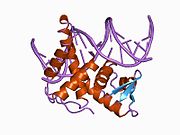| TFDP2 |
|---|
 |
| Available structures |
|---|
| PDB | Ortholog search: PDBe RCSB |
|---|
|
|
| Identifiers |
|---|
| Aliases | TFDP2, DP2, transcription factor Dp-2 |
|---|
| External IDs | OMIM: 602160; MGI: 107167; HomoloGene: 4578; GeneCards: TFDP2; OMA:TFDP2 - orthologs |
|---|
| Gene location (Human) |
|---|
 | | Chr. | Chromosome 3 (human)[1] |
|---|
| | Band | 3q23 | Start | 141,944,428 bp[1] |
|---|
| End | 142,149,544 bp[1] |
|---|
|
| Gene location (Mouse) |
|---|
 | | Chr. | Chromosome 9 (mouse)[2] |
|---|
| | Band | 9|9 E3.3 | Start | 96,196,275 bp[2] |
|---|
| End | 96,323,646 bp[2] |
|---|
|
| RNA expression pattern |
|---|
| Bgee | | Human | Mouse (ortholog) |
|---|
| Top expressed in | - Achilles tendon
- left testis
- right testis
- ventricular zone
- bone marrow cells
- thymus
- ganglionic eminence
- gonad
- epithelium of colon
- olfactory zone of nasal mucosa
|
| | Top expressed in | - blood
- otic vesicle
- myocardium of ventricle
- tibialis anterior muscle
- interventricular septum
- hand
- tail of embryo
- vastus lateralis muscle
- genital tubercle
- Epithelium of choroid plexus
|
| | More reference expression data |
|
|---|
| BioGPS | 
 | | More reference expression data |
|
|---|
|
| Gene ontology |
|---|
| Molecular function | - DNA-binding transcription factor activity
- DNA binding
- transcription factor binding
- protein binding
- transcription coregulator activity
- protein domain specific binding
- RNA polymerase II transcription regulatory region sequence-specific DNA binding
- DNA-binding transcription activator activity, RNA polymerase II-specific
- DNA-binding transcription factor activity, RNA polymerase II-specific
| | Cellular component | - nucleus
- transcription regulator complex
- nucleoplasm
- mitochondrion
- RNA polymerase II transcription regulator complex
| | Biological process | - regulation of transcription by RNA polymerase II
- cell cycle
- negative regulation of transcription, DNA-templated
- regulation of transcription, DNA-templated
- mitotic cell cycle
- DNA damage response, signal transduction by p53 class mediator resulting in cell cycle arrest
- heart development
- transcription, DNA-templated
- positive regulation of protein insertion into mitochondrial membrane involved in apoptotic signaling pathway
- regulation of transcription involved in G1/S transition of mitotic cell cycle
- transcription by RNA polymerase II
- positive regulation of transcription by RNA polymerase II
- negative regulation of G0 to G1 transition
- regulation of cell cycle
| | Sources:Amigo / QuickGO |
|
| Orthologs |
|---|
| Species | Human | Mouse |
|---|
| Entrez | | |
|---|
| Ensembl | | |
|---|
| UniProt | | |
|---|
| RefSeq (mRNA) | NM_001178138
NM_001178139
NM_001178140
NM_001178141
NM_001178142
|
|---|
NM_006286
NM_001375756
NM_001375773
NM_001375774
NM_001375775
NM_001375776
NM_001375778
NM_001375779
NM_001375780 |
| NM_001184706
NM_001184708
NM_001184709
NM_001184710
NM_001184711
|
|---|
NM_178667 |
|
|---|
| RefSeq (protein) | NP_001171609
NP_001171610
NP_001171611
NP_001171612
NP_001171613
|
|---|
NP_006277
NP_001362685
NP_001362702
NP_001362703
NP_001362704
NP_001362705
NP_001362707
NP_001362708
NP_001362709 |
| |
|---|
| Location (UCSC) | Chr 3: 141.94 – 142.15 Mb | Chr 9: 96.2 – 96.32 Mb |
|---|
| PubMed search | [3] | [4] |
|---|
|
| Wikidata |
| View/Edit Human | View/Edit Mouse |
|

 1cf7: STRUCTURAL BASIS OF DNA RECOGNITION BY THE HETERODIMERIC CELL CYCLE TRANSCRIPTION FACTOR E2F-DP
1cf7: STRUCTURAL BASIS OF DNA RECOGNITION BY THE HETERODIMERIC CELL CYCLE TRANSCRIPTION FACTOR E2F-DP





















